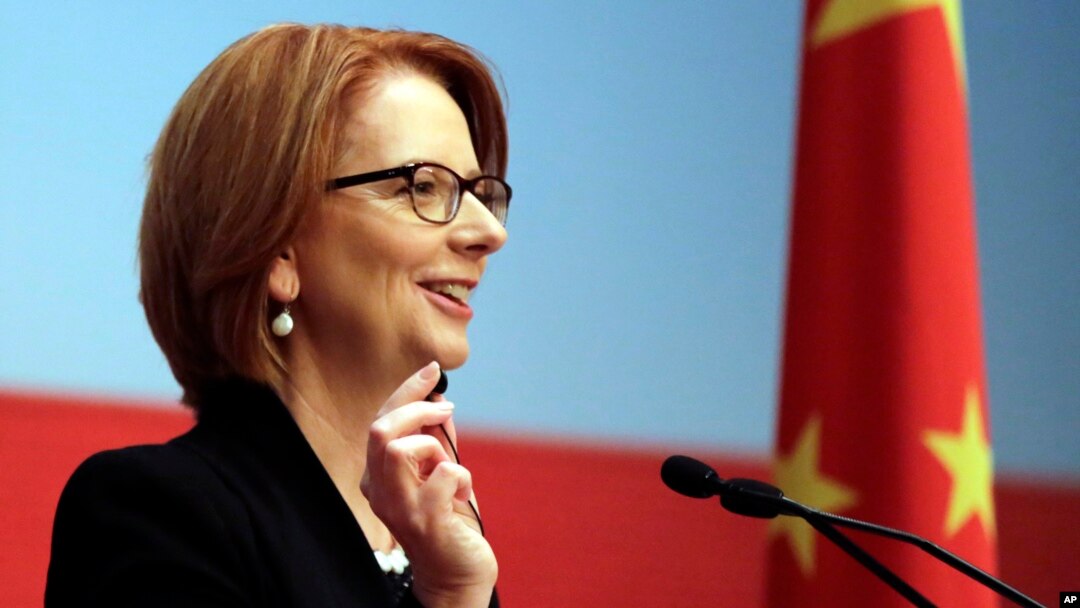SYDNEY —
Australian Prime Minister Julia Gillard says the Australian dollar will be traded directly with the Chinese yuan under a landmark currency deal. The move is part of Canberra’s efforts to strengthen Australia’s burgeoning economic relationship with China.
The currency deal will lower transaction costs for Australian companies doing business in China. No longer will they have to convert their finances into U.S. dollars, and then into Chinese yuan, which is also known as the renminbi. Under the new arrangement, the Australian dollar will be only the third major currency that will be directly tradable with the yuan, after the U.S. dollar and the Japanese yen.
Speaking on an official visit to Shanghai, Australian Prime Minister Julia Gillard said the deal would be a “foundation stone” for future jobs and investment.
China is Australia's biggest trading partner, with combined two-way commerce worth $120 billion. Chinese demand for natural resources, most notably iron ore and coal, helped insulate Australia from the worst of the global financial crisis, although trade in commodities is beginning to slow.
Gillard says the currency deal will boost the Australian economy.
“Australian dollars can be directly traded into renminbi [yuan], into the Chinese currency RMB here in China -- the third currency in the world to do so, after the U.S. dollar and the Japanese yen," she stated. "This is a huge advantage for Australia; not only for our big business, but also for our small and medium enterprises that want to do business here.”
Two of Australia’s biggest banks, ANZ and Westpac, have been granted licenses by Chinese authorities for direct trading.
ANZ is Australia's largest bank in China. Its boss, Mike Smith, says the deal will make doing business in China both cheaper and simpler.
“For example, in a trade document rather than go through U.S. dollars, and having the movement of the currency over time, you can immediately lock in your exchange rate. So you basically are able to create your own forward contract far more easily than you would have been able to do otherwise,” he said.
Banking analysts say the launch of the new Australian dollar-Chinese Yuan trading arrangement is another small step in China’s efforts to increase international use of its currency.
If it could rival the U.S. dollar, analysts believe that Chinese companies would enjoy lower foreign-exchange costs, and bolster China's status in the global monetary system.
In recent months, central banks from Japan, South Korea, and Saudi Arabia have indicated plans to diversify their currency reserves into the yuan.
The currency deal will lower transaction costs for Australian companies doing business in China. No longer will they have to convert their finances into U.S. dollars, and then into Chinese yuan, which is also known as the renminbi. Under the new arrangement, the Australian dollar will be only the third major currency that will be directly tradable with the yuan, after the U.S. dollar and the Japanese yen.
Speaking on an official visit to Shanghai, Australian Prime Minister Julia Gillard said the deal would be a “foundation stone” for future jobs and investment.
China is Australia's biggest trading partner, with combined two-way commerce worth $120 billion. Chinese demand for natural resources, most notably iron ore and coal, helped insulate Australia from the worst of the global financial crisis, although trade in commodities is beginning to slow.
Gillard says the currency deal will boost the Australian economy.
“Australian dollars can be directly traded into renminbi [yuan], into the Chinese currency RMB here in China -- the third currency in the world to do so, after the U.S. dollar and the Japanese yen," she stated. "This is a huge advantage for Australia; not only for our big business, but also for our small and medium enterprises that want to do business here.”
Two of Australia’s biggest banks, ANZ and Westpac, have been granted licenses by Chinese authorities for direct trading.
ANZ is Australia's largest bank in China. Its boss, Mike Smith, says the deal will make doing business in China both cheaper and simpler.
“For example, in a trade document rather than go through U.S. dollars, and having the movement of the currency over time, you can immediately lock in your exchange rate. So you basically are able to create your own forward contract far more easily than you would have been able to do otherwise,” he said.
Banking analysts say the launch of the new Australian dollar-Chinese Yuan trading arrangement is another small step in China’s efforts to increase international use of its currency.
If it could rival the U.S. dollar, analysts believe that Chinese companies would enjoy lower foreign-exchange costs, and bolster China's status in the global monetary system.
In recent months, central banks from Japan, South Korea, and Saudi Arabia have indicated plans to diversify their currency reserves into the yuan.


